Gennaro Cuofano's Blog, page 194
October 8, 2020
What Is Premature Optimization And Why It Matters In Business

Premature optimization describes the act of trying to make something more efficient at a point where it is too early to do so. Here, this focus on efficiency comes at the expense of more important tasks. As an example, before a business sets up marketing automation, it better understands its customers extremely well; otherwise, the risk is to lower the customer experience due to premature optimization.
Understanding premature optimization
Fundamentally, premature optimization is a distraction from completing work that matters. The focus on optimization is often a focus on incremental improvements. However, this diverts resources away from more important tasks.
For example, many businesses spent time and money designing impressive websites without first developing a product that reflects their core values or consumer needs. Here, businesses need to understand their market and leave optimization for the marketing and delivery of their product or service.
Businesses who spend time optimizing processes that don’t matter often have their priorities wrong. They’re also likely to become discouraged and abandon certain projects completely.
At the very least, they will make uninformed decisions that are ultimately not in their best interests.
Premature optimization in the context of software development
The term premature optimization was originally coined by Stanford University professor Donald E. Knuth. He argued that software developers “should forget about small efficiencies, say about 97% of the time: premature optimization is the root of all evil.”
Although the above quote is frequently cited, it is often taken out of context. Knuth does say that premature optimization is evil, but only 97% of the time. He noted that the remaining 3% was critical in releasing a simple product to market that was only optimized where required.
Given that agile and iterative releases are common to the software industry, the perfectionism associated with premature optimization delays a product receiving consumer feedback. In the worst cases, feedback is never received.
As a result, developers do not understand where optimization should be focused. This invariably leads to a product that consumers do not want to buy or use.
Avoiding premature optimization during the product development stage
Regardless of the industry, there are several things a business needs to remember when developing a product or service:
Reduce optimization
A healthy dose of realism will help businesses break out of endless cycles of optimization. They should remember that no product is or ever will be perfect. Businesses who get trapped in this cycle will find that the quality and utility of the finished product will be sub-standard.
They may also find that their competitive advantage has been lost.
Take risks
Imperfect ideas about a product should come to life in the form of a prototype. From there, feedback should be gathered to take the educated risk of turning that prototype into a saleable product.
Resist the urge to develop a product first without the requisite consumer feedback in place.
Consider the 3%
Knuth said that 3% optimization was critical, but the exact number is less important than deciding where to focus optimization effforts.
To this end, it’s helpful to be introspective. What are the advantages and disadvantages of a specific optimization? Does another improvement take precedence, or will it potentially deliver better results?
Furthermore, what are the costs of the optimization, and do the rewards justify the risk? These are some of the questions businesses can use to make sure they are focusing on the worthiest refinements.
Key takeaways:
Premature optimization is the focus on making improvements to a product or service before it is appropriate to do so.Premature optimization was coined by Professor Donald Knuth, who argued that optimization in the early stages of software development was detrimental to success 97% of the time.To avoid premature optimization, self-awareness and the ability to take educated risks can break the somewhat obsessive focus on improvement.
Additional resources:
Successful Types of Business Models You Need to KnowThe Complete Guide To Business DevelopmentBusiness Strategy: Definition, Examples, And Case StudiesWhat Is a Value Proposition? Value Proposition Canvas ExplainedMarketing Strategy: Definition, Types, And ExamplesMarket Segmentation
The post What Is Premature Optimization And Why It Matters In Business appeared first on FourWeekMBA.
What Is Holacracy And Why It Matters In Business
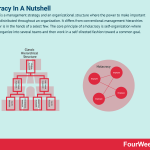
A holacracy is a management strategy and an organizational structure where the power to make important decisions is distributed throughout an organization. It differs from conventional management hierarchies where power is in the hands of a select few. The core principle of a holacracy is self-organization where employees organize into several teams and then work in a self-directed fashion toward a common goal.
Understanding a holacracy
The core principle of a holacracy is self-organization. Instead of having employees waste time waiting for a boss to give them instructions, they organize into several teams and then work in a self-directed fashion toward a common goal.
Indeed, a holacracy empowers employees with responsibility. While they are required to complete their work in a satisfactory time-frame, how that work is completed is left to the teams themselves. This has several benefits for businesses and their employees, including transparency, employee engagement, agility, and better company culture.
Shoe company Zappos and its 1,500 employees are perhaps the most notable example of a company adopting the holacracy approach.
Valve Corporation, a video game software company, is also an advocate. Employees there can work on whatever interests them, but they must take full ownership of the finished product – whatever the outcome.
Advantages and disadvantages of a holacracy structured businesses
Advantages
Purpose-driven. With the hierarchical management style removed, individual employees work toward the same goal which is soon reflected more broadly across the business.Agile customer service. Zappos noted that as the company grew, they were unable to efficiently respond to customer queries because of a convoluted management structure. A holacracy allowed every employee to deliver exceptional customer service without the need to refer enquiries to more senior colleagues.Sets clear expectations. Holacracies by their very nature set clear and transparent objectives, so every employee knows what is expected of them. This negates inefficiencies and the often hidden power struggles that exist in hierarchical organizations.
Disadvantages
Difficult to implement in large organizations. Although the transformation of Zappos into a holacracy was a success story, examples of similar businesses doing the same are uncommon. In some cases, vast amounts of resources must be devoted to re-training. Some managerial styles also become entrenched in company culture and are hard to remove.Lack of accountability. Loosely defined roles in a holacracy without distinct performance standards make it more difficult for HR departments to measure employee capability.Lack of focus. The focus on teamwork can lead to confusion and a lack of focus. Decisions may be debated ad-nauseam, leading to inefficient work practices and the wrong decision being made. Furthermore, some employees have skillsets or personalities that are better suited to solo work.
Key takeaways:
A holacracy is a non-hierarchical governance structure characterized by self-organized groups who hold an equal share of authority and voice.A holacracy empowers employees to become more invested in their careers through open communication and flexible work practices. This strengthens company culture and allows a business to reach its goals. A holacracy creates a purposeful and agile workforce that understands what is expected from them. However, it will not be suited to large organizations with established cultures. The focus on teamwork and loosely defined roles can also lead to substandard employee performance.
Additional resources:
Successful Types of Business Models You Need to KnowThe Complete Guide To Business DevelopmentBusiness Strategy: Definition, Examples, And Case StudiesWhat Is a Value Proposition? Value Proposition Canvas ExplainedMarketing Strategy: Definition, Types, And ExamplesMarket Segmentation
The post What Is Holacracy And Why It Matters In Business appeared first on FourWeekMBA.
Theory of Constraints And Why It Matters In Business
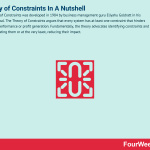
The Theory of Constraints was developed in 1984 by business management guru Eliyahu Goldratt in his book The Goal. The Theory of Constraints argues that every system has at least one constraint that hinders high-level performance or profit generation. Fundamentally, the theory advocates identifying constraints and then eliminating them or at the very least, reducing their impact.
Understanding the Theory of Constraints
The Theory of Constraints was developed in 1984 by business management guru Eliyahu Goldratt in his book The Goal.
In the book, Goldratt uses the chain metaphor to argue that every business system is only as strong as its weakest link. Here, the weakest link is a constraint that limits the extent of profitability. Since there can only be one weakest link, Goldratt suggests that this is where businesses should focus their efforts to institute significant change.
This change is achieved via throughput accounting, which emphasizes selling more of something to generate higher profits. This approach differs from traditional accounting methods that focus on reducing expenses to generate profit.
However, the capacity to reduce expenses is limited once an expense reaches zero. That is, the ability to increase profits is constrained.
Conversely, the emphasis on increasing sales revenue via throughput accounting has no such constraint. This is because – at least in theory – there is no limit to the amount of sales revenue a business can generate.
Throughput accounting is comprised of three parts:
Throughput – or the rate of sales revenue generated by a product or service. Inventory – or money that is tied up in physical things such as raw materials, equipment, distribution facilities, and goods awaiting sale.Operating expense – or the money a business spends creating throughput to maintain a desired level of capacity. This may include payroll, depreciation, and utility expenses.
The five steps of the Theory of Constraints
1. Identify the constraint
Which part of the system constitutes the weakest link? Remember, there can only be one.
2. Exploit the constraint
Use available resources to make rapid improvements to the constraint. Reduce or eliminate where possible to avoid expensive wholesale upgrades or process changes.
3. Subordinate the remaining links
The unconstrained (strong) links in a process must be altered so they maximize the output of the weakest link. At this point, the process should be evaluated to determine if the constraint has simply shifted to another location on the chain.
If the constraint has been eliminated, the business can move to step five. Otherwise, they should proceed to step four.
4. Elevate the constraint
If the second and third steps have not been successful, take whatever action necessary to eliminate the constraint. This includes a major overall of an existing system.
5. Beware of inertia
Once a constraint has been removed, avoid becoming complacent.
Understand that the Theory of Constraints is a cyclical process that stresses the importance of improving one constraint and then moving on to the next. Complacency, which Goldratt calls “inertia”, is a significant barrier to profit generation through increased production.
Key takeaways:
The Theory of Constraints is a management philosophy stating that any system is prevented from achieving its full potential by one or more key constraints.The Theory of Constraints focuses on constraints in the context of their ability to reduce profits. As a result, the theory focuses on throughput accounting and its core principle of increasing production capacity to generate revenue.The Theory of Constraints is a five-step, cyclical process that businesses must consistently use to avoid becoming complacent.
Additional resources:
Successful Types of Business Models You Need to KnowThe Complete Guide To Business DevelopmentBusiness Strategy: Definition, Examples, And Case StudiesWhat Is a Value Proposition? Value Proposition Canvas ExplainedMarketing Strategy: Definition, Types, And ExamplesMarket Segmentation
The post Theory of Constraints And Why It Matters In Business appeared first on FourWeekMBA.
Second-Order Thinking And Why It Matters In Business

Second-order thinking is a means of assessing the implications of our decisions by considering future consequences. Second-order thinking is a mental model that considers all future possibilities. It encourages individuals to think outside of the box so that they can prepare for every and any eventuality. It also discourages the tendency for individuals to default to the most obvious choice.
Understanding second-order thinking
In life and in business, it is tempting to prioritize decisions with small upside that provide instant gratification. This is often referred to as first-order thinking, which is simplistic and superficial by nature. First-order thinking does not consider the negative ramifications of a decision in the future.
An investor with first-order thinking might believe that a favorable company outlook means its share price will rise. Similarly, an overweight individual might conclude that the best choice for a hungry stomach is a chocolate bar. In both cases, the potentially negative future consequences of each choice have not been duly considered.
Ultimately, second-order thinkers perform better than first-order thinkers because they can see solutions to problems that others can’t.
Implementing second-order thinking in practice
Here is a basic framework for adopting second-order thinking:
The next time you are faced with a problem or decision, note down the first solution that comes to mind. In other words, the first-order thinking solution.Then, evaluate the future consequences of the first-order decision to the second, third, and fourth orders. For each respective level of decision making, identify the potential positive and negative outcomes.In the third step, evaluate the risks of each decision as objectively as possible. How will your decision impact others and what might they think about the decision? Why do you think your decision is right? Is there a simpler solution?Re-examine second, third, and fourth-order decisions, even if the immediate consequences are negative. This helps identify choices that favor short term pain for long term gain.Learn to utilize feedback loops to help you make better decisions. In other words, will the decision you make give you accurate and timely feedback on its effectiveness? Here, it’s important to realize that the power of good decision making compounds over time – so continue to rework and refine your processes.
An example of second-order thinking in business
During recruitment, individuals are often hired because of their ability to fill a vacant position and not on their actual qualifications. Hiring managers who use first-order thinking fill positions because of budget or time constraints and do not objectively assess the credentials of the interviewee.
Second-order thinkers, on the other hand, analyze the consequences of rushing the hiring process. Will the new employee need to be retrained, counseled, or terminated because of poor performance? Will the re-advertising of the position place further pressure on budgetary or time constraints?
Key takeaways:
Second-order thinking is a mental model that allows individuals to travel beyond their comfort zones and objectively analyze the consequences of future decisions.Second-order thinking is a creative approach to problem-solving that prepares businesses for all scenarios, leading to greater efficiency. Second-order thinking is most rigorous when second, third, and fourth-order consequences are analyzed objectively using feedback loops. These loops provide valuable feedback on whether a given solution might be viable.
Additional Resources:
Successful Types of Business Models You Need to KnowThe Complete Guide To Business DevelopmentBusiness Strategy: Definition, Examples, And Case StudiesWhat Is a Value Proposition? Value Proposition Canvas ExplainedMarketing Strategy: Definition, Types, And ExamplesMarket Segmentation
The post Second-Order Thinking And Why It Matters In Business appeared first on FourWeekMBA.
S-Curve In Business And Why It Matters
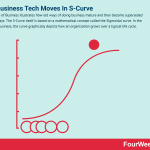
The S-Curve of Business illustrates how old ways of doing business mature and then become superseded by newer ways. The S-Curve itself is based on a mathematical concept called the Sigmoidal curve. In the context of business, the curve graphically depicts how an organization grows over a typical life cycle.
Understanding the S-Curve of Business
A key argument of the curve is that sooner or later, most businesses will reach a period of stagnation – no matter how successful they were in the past. At the point of stagnation, the business reaches an inflection point. At this point, it will be forced to innovate to grow and remain competitive.
For executives, understanding where their business lies along the S-Curve is crucial. If the business has already reached an inflection point – also referred to as a “stall point” – it has less than a 10% chance of fully recovering.
In the next section, we’ll discuss these terms at various points of the life cycle in more detail.
The stages of the S-Curve life cycle
Initially, start-up companies begin at the bottom of the curve with a product or service they are taking to market.
If they are lucky, their offering gains traction – albeit very slowly at first and then gradually quickening as more consumers become aware. This is the first inflection point, where sales and revenue increase rapidly after an initial period of stagnation or low growth.
While growth will continue for some time, a host of internal or external factors will eventually cause growth to decrease and then taper off.
These factors include:
Market saturation.The rising influence of a competitor.Emerging technology that is more profitable.A change in leadership resulting in poor management.
Here, the business encounters the second inflection point. At this point, a critical decision must be made. For the growth curve to start anew and begin trending upward, the business must innovate and ride the wave of technological advancement.
Ultimately, a business at the second inflection point that then tries to innovate is already too late. Inflection points must be identified before they occur so that businesses have adequate time to develop new products that have a high chance for success.
How do businesses commonly reach stall points?
External factors
Economy – most businesses will find it hard to maintain growth during recessions since consumers are spending less.Politics – when state or federal laws are enacted to regulate or ban certain products or services, businesses must have the ability to pivot quickly.Trends – this is particularly prevalent in technology where trends shift quickly. Examples of companies unknowingly reaching inflection points because of technology include Nokia, Blackberry, Xerox, and Kodak.
Internal factors
Dilution of focus. Many start-ups have visionary leaders whose sole intent is to serve their customers well. But when companies become larger, focus and effort can become diluted – particularly as management becomes more convoluted.Talent shortage – for whatever reason, some companies are hindered in their growth because they cannot source the required talent to make it happen.
Key takeaways:
The S-Curve of Business allows a company to determine where it is on a typical growth life cycle, and adjust its strategies accordingly.The S-Curve of Business life cycle consists of two inflection points. The second is the most critical, as it signifies that a business has reached a growth ceiling.Inflection points are caused by a variety of factors relating to the economy, consumer trends, and talent shortages. Whatever the cause, managers must identify them ahead of time and develop strategies to maintain growth.
Additional Resources:
Successful Types of Business Models You Need to KnowThe Complete Guide To Business DevelopmentBusiness Strategy: Definition, Examples, And Case StudiesWhat Is a Value Proposition? Value Proposition Canvas ExplainedMarketing Strategy: Definition, Types, And ExamplesMarket Segmentation
The post S-Curve In Business And Why It Matters appeared first on FourWeekMBA.
What Is DevSecOps And Why It Matters In Business

DevSecOps is a set of disciplines combining development, security, and operations. It is a philosophy that helps software development businesses deliver innovative products quickly without sacrificing security. This allows potential security issues to be identified during the development process – and not after the product has been released in line with the emergence of continuous software development practices.
Understanding DevSecOps
DevSecOps is an integrative approach to coherent and effective software delivery.
In the past, software developers would typically update their products every few months or years. This gave the company enough time to test its code for potential security breaches by employing specialist contracted teams.
In the past decade, however, the rising prevalence of cloud and microservice models has resulted in rolling releases and thus a more agile market. Rapidity is now the name of the game, with many processes now automated and shared information readily available.
In some cases, security has not been able to keep up with the rapid pace of development. This is where the DevSecOps approach is vital.
By building security into every stage of development, the business can significantly reduce the costs associated with security flaws. In this sense, DevSecOps is a pro-active strategy because it anticipates security breaches before they occur.
Advantages of the DevSecOps approach
Businesses who engage in the DevSecOps approach can expect several benefits, including:
Reduced costs. Security issues that are rectified in the development process is more cost-effective than addressing the same issues after the product has gone to market. This also reduces costs by shortening product delivery times.Avoids bad publicity. Security issues that are detected in-house cannot cause the product or the business negative publicity.Creates a positive company culture. A core tenet of the DevSecOps approach is that every member of the development team is responsible for security. This encourages a cohesive and transparent workplace culture that drives better outcomes.Higher overall security. Software developed via the DevSecOps approach is more robust. In other words, the strategy reduces general vulnerabilities and insecure defaults. It also increases code coverage and automation through robust infrastructure.
DevSecOps best practices
To ensure that the process runs smoothly, development teams should first realize that there is nothing wrong with automation – so long as automated security controls are also part of the software development cycle.
Teams should also employ tools that efficiently scan code as it is written for potential security issues. If issues are detected, then it is important to run threat-modeling scenarios to identify and then build protection against issues deemed a significant threat.
Key takeaways:
DevSecOps stands for development, security, and operations. It is a pro-active and iterative approach to preventing security breaches during software development.The DevSecOps allows software businesses to keep pace with both the rapidly advancing software market and the collaborative, more rapid way software is developed.DevSecOps has many benefits for businesses, including reduced costs and enhanced company culture. The approach also allows development teams to identify issues that could potentially hurt brand image once the product is released.
Read Also: Fastly Business Model, Snowflake Business Model, Sumo Logic Business Model
Additional resources:
Successful Types of Business Models You Need to KnowThe Complete Guide To Business DevelopmentBusiness Strategy: Definition, Examples, And Case StudiesWhat Is a Value Proposition? Value Proposition Canvas ExplainedMarketing Strategy: Definition, Types, And ExamplesMarket Segmentation
The post What Is DevSecOps And Why It Matters In Business appeared first on FourWeekMBA.
Amazon PESTEL Analysis In A Nutshell
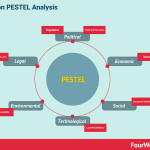
Amazon future success is influenced by Political (new regulations and potential breakups of the company), Economic (new global economic dynamics influencing e-commerce adoption), Social (changing consumer behavior at a global level), Technological (new technological challenges, like last-mile delivery at scale), Environmental (enabling sustainable operations), and Legal (compliance with international laws).
Amazon PESTEL Analysis Introduction
This article will evaluate the global retail giant Amazon in the context of a PESTEL Analysis.
A PESTEL analysis is a framework businesses can use to assess the external (macro) factors of the environment they operate in.
[image error]The PESTEL analysis is a framework that can help marketers assess whether macro-economic factors are affecting an organization. This is a critical step that helps organizations identify potential threats and weaknesses that can be used in other frameworks such as SWOT or to gain a broader and better understanding of the overall marketing environment.
PESTEL is an acronym of the following external factors:
P – Political.E – Economic.S – Social.T – Technological.E – Environmental.L – Legal.
Amazon PESTEL Analysis
Let’s now perform a PESTEL Analysis on Amazon, addressing each factor in more detail.
Political
Political factors encompass the level of governmental intervention in an economy. This may include policy decisions relating to foreign trade and tax or laws relating to labor or the environment.
As a global retailer, Amazon is not immune to political factors. Politically stable western countries with similar laws to the USA offer Amazon expansion opportunities. However, the company has faced stiff competition in China where the government tends to back Chinese e-commerce companies.
Economic
Economic factors are those that directly impact on the performance of the economy. In turn, these factors influence the profitability of an organization. Economic factors may include unemployment rates, raw material costs, and foreign exchange rates.
In the wake of the coronavirus pandemic, Amazon has benefitted tremendously from economic stimulus measures that have increased consumer discretionary income. However, this income has also allowed competitors to enter the market.
Social
Social factors describe the general beliefs and attitudes of a population, most often related to cultural and demographical trends. These factors ultimately determine and then drive consumer behavior.
With the shift toward convenient, fast, and contactless delivery, Amazon has again taken advantage. Savvy and computer literate millennial consumers are also driving huge growth in mobile shopping as the availability of 5G networks increases.
Technological
This describes the rate of technological innovation and development and how it might influence a given market. Digital technology is often the focus, but non-tech companies also look for advances in distribution, manufacturing, and logistics.
Amazon is highly innovative within the retail sector. The company has invested heavily in drones to deliver parcels. It has also created an unattended locker system called Amazon Hub so that consumers can receive parcels when it is convenient for them to do so.
Environmental
In the 21st century, environmental factors are becoming increasingly prevalent. They encompass such things as carbon footprint, waste disposal, and sustainable access to raw materials. Climate change has also meant that businesses must be more adaptable to frequent natural disasters.
As Amazon’s distribution network grows, the company must sustainably address its greenhouse gas emissions. In the United States, Amazon Prime is particularly polluting because of the promise of 1 or 2-day delivery.
Legal
Large organizations that operate in many countries must have a detailed understanding of the laws applicable to each. This is especially true in countries where employment, consumer, tax, and trade law directly impacts on business operations.
Amazon has had to deal with legal challenges regarding its tendency to subvert tax law and move profits into tax havens such as Luxembourg. The company was also recently investigated by the US Federal Trade Commission for misleading discount claims on over 1000 of its products.
Key takeaways:
The PESTEL analysis is a tool that businesses use to analyze macro-environmental factors that have the potential to impact on performance.PESTEL is an acronym for six factors: political, economic, social, technological, environmental, and legal.As a large, global retail company, Amazon has been able to take advantage of the shift toward convenient and contactless consumer goods delivery. However, it’s global reach also leaves it vulnerable to sustainability trends and investigation for tax evasion.
Read also: Amazon Business Model, Amazon SWOT Analysis, SWOT Analysis
Other readings:
What Is the Receivables Turnover Ratio? How Amazon Receivables Management Helps Its Explosive GrowthAmazon Case Study: Why from Product to Subscription You Need to “Swallow the Fish”What Is Cash Conversion Cycle? Amazon Cash Machine Business Model ExplainedWhy Is AWS so Important for Amazon Future Business Growth?Amazon Flywheel: Amazon Virtuous Cycle In A NutshellAmazon Value Proposition In A NutshellWhy Amazon Is Doubling Down On AWSThe Economics Of The Amazon Seller Business In A NutshellHow Much Is Amazon Advertising Business Worth?What Is the Cost per First Stream Metric? Amazon Prime Video Revenue Model ExplainedJeff Bezos Teaches You When Judgment Is Better Than Math And DataAlibaba vs. Amazon Compared in a Single InfographicAmazon Mission Statement and Vision Statement In A NutshellThird-Party Sellers And Amazon’s Platform-First Business, Will It Last?Business Strategy ExamplesBusiness ModelsPorter’s Five Forces
The post Amazon PESTEL Analysis In A Nutshell appeared first on FourWeekMBA.
October 1, 2020
The Business Models Books You Should Be Reading In 2020
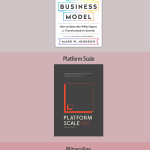
When you purchase an iPhone, you’re not buying a piece of hardware, you’re buying an ecosystem and an innovative business model, all packaged together.
You might not be realizing that companies that create a lasting advantage also innovated their business model. But when Apple is selling you an iPhone at a very high-profit margin, it’s using a reverse razor and blade business model strategy.
Where the content you can download on iTunes and the countless number of Apps you can find on the Apple Store, is given to you either for free or for a low price and no friction.
While its piece of hardware is getting sold to you at a high price, in this scenario, understanding how business models work is critical.
Thus, I’m suggesting five books that helped me navigate in the topic by combining theory and practice. I’m not earning any affiliations from those books (you might notice there is no link to them).
Those are books I believe you must read if you want to develop an un-understanding of the discipline, quickly.
100+ Business Models Book by FourWeekMBA
This is our flagship book, the master guide to get you from basics to advanced in the shortest time possible:
The Business Model Navigator
The business model navigator is a book that comes out from the research of Oliver Gassmann, Karolin Frankenberger, and Michaela Csik. There are a few aspects I liked the most about these books.
First, as I remembered several times on this blog, there isn’t a single definition of business modeling. And according to the definition given to the subject, it also changes the methodology and tools you can use and apply to gain insights over your business.
Often a good analysis might be coming from balancing the several tools available. The business model navigator has a straightforward way to understand and define business models.
Also, the authors have done massive and exciting research into 55 and over business model patterns that have shaped our times. It is an excellent source of inspiration.
[image error]
Blitzscaling
The amount of insights and knowledge distilled in the book is massive. Reid Hoffman, founder of LinkedIn together with Chris Yen, goes through a methodology they called Blitzscaling.
Look at it as growth hacking on steroids. Where growth hacking tries to define a process to find growth, quickly.
Blitzscaling focuses on 10x growth, especially in situations where the business might be threatened by competition and either survive or die in the short term.
It’s about going all in. As Reid Hoffman puts it “An entrepreneur is someone who will jump off a cliff and assemble an airplane on the way down.” Blitzscaling is almost like building the world’s largest aircraft on the way down.
Blitzscaling also offers an alternative way to look at business model innovation, which can be summarized in the infographic below:
[image error]
And the canvas below:
[image error]
You might want to read this!
[image error]
Reinvent Your Business Model
Having a set of tools for your business means being able to understand what tool might work best in specific scenarios.
In the case of a mature company that is well established in a business model, but suddenly needs to reinvent itself to keep being successful in the long run, this is the best reading.
Indeed, this book helps you understand where is the white space for your business and how to go after it. In that respect is also offers you an alternative way to look at your business model:
[image error]
Business Model Generation
This is a classic in the business modeling literature. It will introduce you to the concept of the business model canvas, which focuses on a few key elements such as:
Key partners
Key activities
Value proposition
Customer relationship
Customer segment
Key resource
Distribution channel
Cost structure
Revenue stream
This is a must-read:
[image error]
Platform Scale
In the era of digital business models, platforms have become the most emerging and influential tech companies. The authors do a fantastic job ad deconstructing the way those platforms work and the tactics they have used to scale up:
[image error]
What other book have you found it worked for you to understand business modeling?
The resources you need to get started with your business model:
Business Strategy: Definition, Examples, And Case Studies
What Is a Business Model? 30 Successful Types of Business Models You Need to Know
What Is a Business Model Canvas? Business Model Canvas Explained
Blitzscaling Business Model Innovation Canvas In A Nutshell
What Is a Value Proposition? Value Proposition Canvas Explained
What Is a Lean Startup Canvas? Lean Startup Canvas Explained
How to Write a One-Page Business Plan
The Rise of the Subscription Economy
How to Build a Great Business Plan According to Peter Thiel
What Is The Most Profitable Business Model?
The Era Of Paywalls: How To Build A Subscription Business For Your Media Outlet
How To Create A Business Model
What Is Business Model Innovation And Why It Matters
What Is Blitzscaling And Why It Matters
Snapshot: One Year Of “Business Model” Searches On Google In Review
Business Model Vs Business Plan: When And How To Use Them
The Five Key Factors That Lead To Successful Tech Startups
Top 12 Business Ideas with Low Investment and High Profit
Business Model Tools for Small Businesses and Startups
How To Use A Freemium Business Model To Scale Up Your Business
Popular case studies from the blog:
The Power of Google Business Model in a Nutshell
How Does Google Make Money? It’s Not Just Advertising!
How Does DuckDuckGo Make Money? DuckDuckGo Business Model Explained
How Amazon Makes Money: Amazon Business Model in a Nutshell
How Does Netflix Make Money? Netflix Business Model Explained
How Does Spotify Make Money? Spotify Business Model In A Nutshell
The Trillion Dollar Company: Apple Business Model In A Nutshell
DuckDuckGo: The [Former] Solopreneur That Is Beating Google at Its Game
The post The Business Models Books You Should Be Reading In 2020 appeared first on FourWeekMBA.
September 29, 2020
What Are SMART Goals And Why They Matter In Business

A SMART goal is any goal with a carefully planned, concise, and trackable objective. To be such a goal needs to be specific, measurable, achievable, relevant, and time-based. Bringing structure and trackability to goal setting increases the chances goals will be achieved, and it helps align the organization around those goals.
Understanding SMART goals
“SMART” is an acronym which explains how a goal might be achieved. Here is a more detailed look at each letter in the SMART acronym.
S – Specific
When considering the goal, it helps to be as specific as possible. Many individuals and businesses set goals with arbitrary dollar amounts, such as becoming a millionaire or generation 10 million dollars in revenue. If the goal is to make a certain amount of money, a more specific objective may be to make $40,000 per month for the next 5 years by selling 2500 units of a new software product.
Here, it helps to ask questions. What is it, in exact terms, that an individual or business hopes to achieve? Where, how, and when will this occur? What are the reasons for setting the goal in the first instance?
M – Measurable
Measurable goals have metrics that are used to gauge progress. This is particularly important for large and complex goals that must be broken down into smaller steps. Measurable goals also let the individual or business know that they have reached the finished line.
A- Achievable
Goals must be realistically achievable, otherwise, the temptation may be to give up on achieving them entirely. Businesses should set goals that their employees could reasonably expect to see through – given the materials and resources at hand. It’s also important to identify any short or long term impediments that may divert these resources.
R – Relevant
Relevance means that individuals and businesses set goals that are aligned with their values and long-term objectives. There is no point setting goals for the sake of it – so ensure that the reasons for conceiving a goal are aligned with broader strategies and company culture.
T – Time-based
Goals by their very definition need a deadline, particularly in business settings. Time-based goals are also important in tracking progress and setting milestones. For example, a business wanting to double its revenue in 6 months would hope to increase revenue by 50% after the 3-month mark.
Some common mistakes when setting SMART goals
Vagueness
Clarity is key when setting SMART goals. A marketing department might not know where to start when presented with the goal of selling 5000 cars in the next 4 years. However, the more specific goal of selling 5000 small cars in Italy by the end of 2025 gives them something to work with.
No KPIs
If the goal is to improve customer service, then there must be a customer service KPI with which to gauge progress. Many businesses make the mistake of setting goals that simply can’t be measured. Here, quantitative or industry research is key.
Unattainability
If a business is particularly successful, it is easy to get carried away with goal setting. An ambitious goal of selling 1 million pairs of shoes in the next 5 years is daunting and maybe unattainable without the required due diligence. In this case, smaller goals of selling 20,000 pairs every 3 months may be more suitable.
Key takeaways:
SMART goals are those that are carefully planned against certain criteria to increase the chances of them being accomplished.SMART goals are specific, measurable, achievable, relevant, and time-based.Some common mistakes when setting SMART goals include those not backed by reliable KPIs or those that are simply unattainable in the recommended timeframe.
SMART Goals vs. OKR
[image error]Andy Grove, helped Intel become among the most valuable companies by 1997. In his years at Intel, he conceived a management and goal-setting system, called OKR, standing for “objectives and key results.” Venture capitalist and early investor in Google, John Doerr, systematized in the book “Measure What Matters.”
SMART goals and OKR are very similar tools, however, SMART goals are used more for personal development. Where instead OKR is a goal-setting system primarily thought for teams. So how to enable large organizations to achieve their goals at scale.
Therefore, while in terms of mindset SMART and OKR are similar. SMART usually are used more by solopreneurs, where OKR are used by startups and larger organizations.
SMART Goals vs. OKR vs. MBOs
[image error]
Management by Objectives or MBO is a strategic management tool whose core principle is to define organizational objectives to align management with employees clearly. OKR is an evolution, as it breaks the silos and makes the shared objectives transparent to the whole company.
And those same objectives are aggressive and aspirational. SMART Goals can be used in the direction of OKRs but more at a personal level or at a smaller scale.
OKR and 10x thinking
OKR has been a system widely used in companies like Google to help scale up, while still aligning the company around so-called moonshots. Or small and larger bets that can make the company breakthrough in various verticals.
As OKR is by nature aggressive and aspirational, it fits well with the 10x thinking mindset.
[image error]Moonshot thinking is an approach to innovation, and it can be applied to business or any other discipline where you target at least 10X goals. That shifts the mindset, and it empowers a team of people to look for unconventional solutions, thus starting from first principles, by leveraging on fast-paced experimentation.
Related reousrces:
OKK Goal-Setting System 10X ThinkingGoogle Business ModelGoogle Bets
Handpicked business resources:
Business ModelsBusiness StrategyDigital Business ModelsDistribution ChannelsGo-To-Market StrategyMarketing StrategyNetwork EffectsPlatform Business ModelsRevenue Models
The post What Are SMART Goals And Why They Matter In Business appeared first on FourWeekMBA.
September 25, 2020
Competitive Analysis Matrix In A Nutshell

The Competitive Analysis Matrix is a tool that allows businesses to define new growth opportunities. As the name suggests, the matrix is used to critically profile a company against its main competitors. The purpose of the Competitive Analysis Matrix is to provide a broad overview of the competitive landscape in a given industry. It helps businesses quickly identify gaps in product or service features and develop a point of differentiation as a result.
Understanding the Competitive Analysis Matrix
The matrix itself is simply a spreadsheet with specific features of an industry assigned to each row and the players (or competitors) of an industry assigned to each column. Then, each player is given a score based on how well they satisfy each feature. In most matrices, 1 is the lowest score and 5 is the highest.
For example, a budget airline may score a 5 for affordability but a 3 for customer service and a 2 for in-flight dining. A competitor may then use the matrix to see if it might be able to offer better customer service and food choices while remaining competitive in the budget airline industry.
Four elements of a basic Competitive Analysis Matrix
Grouped feature sets. To simplify the matrix, it’s important to group related features into a single row. Some large and complex industries may have hundreds of assessable features, which can quickly lead to overwhelm for analysts.A holistic view. Although the matrix is touted as identifying gaps in the features of products or services, businesses should not stop there. Instead, they should look at attributes that affect the entire business to consumer process. These include delivery, installation, distribution, and after-sales support. Accurate measurements. Remember that the Competitive Analysis Matrix is a qualitative comparison. Refrain from giving yes or no answers.Customer focus. Resist the urge to assess product features that competitors are offering, since many of these features are superfluous to consumer needs. Indeed, the best approach is to determine what the consumer wants and then measure success against those features.
Disadvantages of the Competitive Analysis Matrix
Like many adaptable competitive matrices, there are some limitations to using the Competitive Analysis Matrix.
These include:
Subjective scores. Given that the scores for each attribute are subjectively assigned, there is likely to be some degree of inaccuracy. This is particularly prevalent when a business assigns scores to its competitors.Incomplete information. While one business may know its distribution network inside and out, it may be difficult to obtain sufficient publicly available information on the network of a competitor. Dependent attributes. In some cases, a strength in one attribute may result in the weakness of another within the same organization. For example, the low-fare model (strength) of a budget airline may be diluted if the airline opts to increase the poor standard of their food (weakness). In this case, the fixing of the weakness creates another competitive disadvantage if the airline cannot maintain its low prices.
Key takeaways:
The Competitive Analysis Matrix allows businesses to quickly assess their market positioning and determine where their competitive strengths lie.The Competitive Analysis Matrix should have four elements as a bare minimum: grouped feature sets, a holistic view, accurate measurements, and a focus on consumer needs.The Competitive Analysis Matrix has several limitations, owing to subjective and sometimes dependent attributes and also a lack of publicly available information.
Other strategy frameworks:
AIDA ModelAnsoff MatrixBalanced ScorecardBCG MatrixDesign ThinkingFlywheelLean Startup CanvasOKRPestel AnalysisTechnology Adoption CurveTotal Addressable Market
Additional resources:
Market SegmentationSuccessful Types of Business Models You Need to KnowThe Complete Guide To Business DevelopmentBusiness Strategy: Definition, Examples, And Case StudiesWhat Is a Value Proposition? Value Proposition Canvas ExplainedMarketing Strategy: Definition, Types, And Examples
The post Competitive Analysis Matrix In A Nutshell appeared first on FourWeekMBA.



